英语论文模版
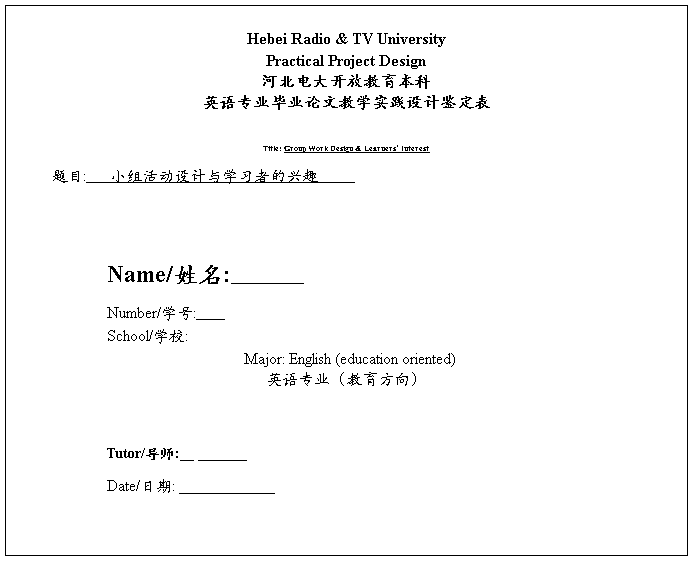
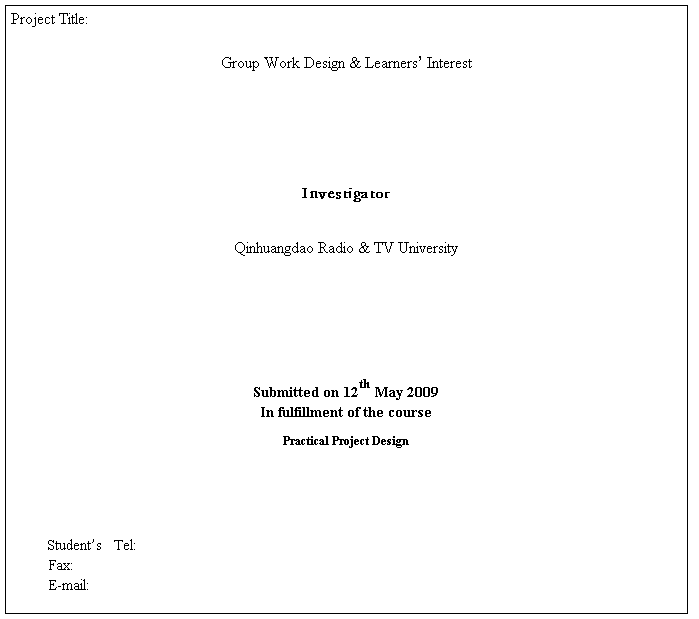
开放本科英语专业(教育方向)毕业论文
附录一:中文封面页
附录二:英文封面页
附录三:致谢
附录四:中文摘要
附录五:英文摘要
附录六:目录
附录七:教师指导记录表
附录八:开题报告
河北广播电视大学开放教育本科
英语专业(教育方向)毕业论文
教学实践设计
小组活动设计与学习者的兴趣
项目设计者
姓名:
学号:
学校:秦皇岛广播电视大学
提交日期:20##年5月12日
Hebei Radio & TV University
Practical Project Design
English Major (education oriented)
Group Work Design & Learners’ Interest
Investigator
Name:
Student No.:
School:Qinhuangdao Radio & TV University
Submitted on May12th 2009
Acknowledgement
I really appreciate my tutor Miss wang, whose help and patience made this project get off the ground and come to a close smoothly.
I am also grateful to my colleagues C S, M J and for their time spent on brainstorming and panel discussions with me.
No amount of thanks will be adequate for my students without whose willing participation in the project implementation it would have remained on paper.
Last but not the least, thanks are given to my parents who have shared with me my worries, frustrations, and hopefully my ultimate happiness in eventually finishing this project.
摘 要
本文研究了肢体语言在中学教学中的应用。有的教师可能认为肢体语言在小学占有很重要的地位,而在中学却可有可无。其实肢体语言在中学的教学中仍是必不可少的。我专门设计的四个星期的课堂教学实践活动证实了这个假设。
在实验过程中使用了问题分析法、问答法、原因分析法、集思广益、问卷调查、采访理论方法验证了这个假设。
关键词:肢体语言;方法
Abstract
The thesis study about the use of the body language in middle school. Some teacher may think that it’s important in primary school,and it’s nothing in middle school.In fact,it also play an important role in the teaching of middle school This hypothesis is verified by a four-week practice of classroom teaching with the specially designed group work exercise activities.
Among the methods of scientific investigation used are the analytic method , Socratic dialogue , cause analysis , brainstorming, questionnaire survey and interview .
Key words: interest, methods
Contents
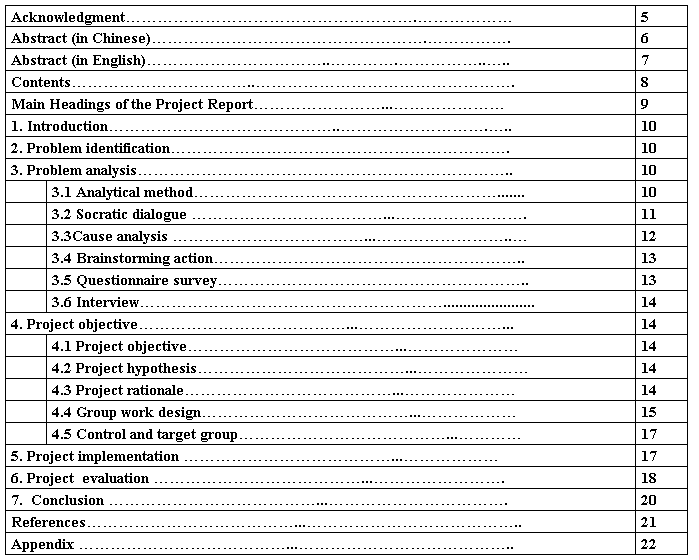
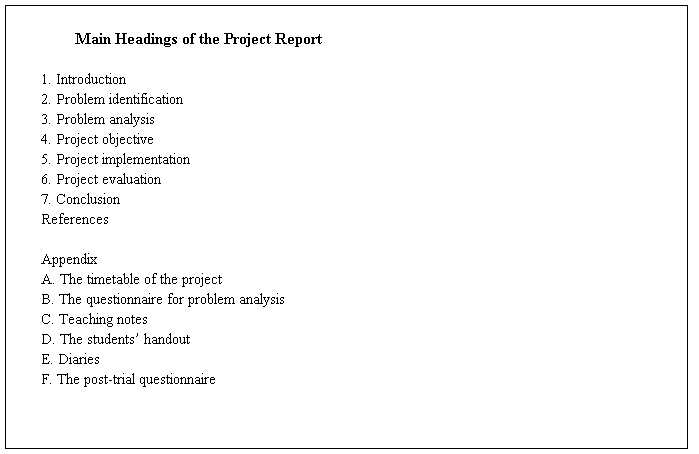
Group Work Design & Learner’s Interest
1. Introduction
I have been teaching the students who are in a junior middle school for eight years.
In my teaching I’ve found there are some problems. Now I’ll finish my study in TV University. I hope I can solve the problem that have troubled me for some time through the action research so that I can apply my knowledge an theory into practice , which I learned from TV University .
2. Problem identification
I identified a problem based on my teaching experience. That is some of my students do not like doing group work. They are not interested in doing group work.
I examined my problem scientifically to see whether it is researchable.
I discussed and agreed the problem with the tutor. At the same time, I worked out the timetable of my project. (To see Appendix A)
3. Problem analysis
In my teaching, the problem identified was really a serious problem.
My preliminary research confirmed that there were three main man reasons that accounted for students reluctance to do the group work.
Firstly, some students are not interested in doing group work, They think they can’t speak English as well as other student.
Secondly, they did not master enough words and phrases. So they can’t express themselves well. Thirdly, some students don’t like finishing the report of their group work. Because the reports are part of their homework. The students think the report as burden.
The problem has been troubling me for a long time and I was determined to find a solution to the problem.
3.1The analytic method
Some of my students showed no interest in group work. But others didn’t. Why my students showed two opposite behaviors. So I asked my colleagues if they had this problem. Some of their answers were “yes”. Moreover, “my students” was in contrast with “my colleagues’ students”. This preprinted me to make a chain of reflections. Why some of my colleagues did not say “yes”. If I were in contrast with them, then my problem should be actually caused by myself, not by my students. Perhaps my explanation was not clear, or my task design was poor.
Through the above analysis I realized that my problem was probably caused by my poor task design and explanation about English speaking skills.
3.2 Socratic dialogue
I can’t get my students to talk in English.
→ What do I mean by talk? What sort of talking do I expect of them?
Well, I want them to discuss in pairs or groups.
→ But discuss what?
I give them topics to talk about.
→ What sort of topics?
Well, usually the dialogue in their textbook.
→ What purpose do they have in discussing this topic?
Purpose? To practice speaking in English.
→ Isn’t it like me going shopping?
Going shopping? Ah…… I often go shopping, but to not actually buy anything, simply because I do not have a specific purpose.. I regret wasting my time after-wards.
→ Ah… here is the point. When I ask my students to work in group to do a report, the purpose of practicing English is too general. It is like the purpose of going shopping. I should give them some specific purposes, genuinely communicative goals, analogous to such specific purposes in shopping, such as buying a T-shirt or a tube of toothpaste.
Gosh, I should have seen this pint earlier. If students have no reason to talk, then why will they bother?
→ Indeed! What if the conversation goes like this:
Student A (to Student B): I agree with the text.
Student B (to Student A): So do I.
What more is there to say? The topic clearly doesn’t interest them to give more opinions on it and there is no other reason for them to discuss it anymore. So, the conversation ends. This is perfectly natural.
Through Socratic dialogue, I had come to this realization: my design of pair work exercises was problematic.
3.3Cause analysis
I started with a list of factors that might contribute to the causes.
The teacher’s side
The student’s side
The task design
The class size
The classroom management
Then I worked on each of the factors to see if there were any potential causes.
The teacher’s side ------- that is myself
◇ I was not enthusiastic myself
◇ I failed to give instructions clearly.
◇ I did not do any monitoring. I simply sat there, reading.
The students’ side
◇ Some students, especially the top ones, would rather give answers in class to impress their teachers than exchange opinions with their peers.
◇ Some weak students lacked confidence in voicing their own opinions. They are afraid of making mistakes and being laughed at by their peers.
◇ Still others were accustomed to the traditional pattern of teaching and learning, that is, the teacher teaches while they either listen passively or repeat what is said verbatim. As a result, they felt uncomfortable when they were asked to communicate and express themselves in groups.
◇ Students’ personality may have some influence as well. Those exhibiting introvert features, for example, may dislike pair work.
The task design
◇ As analyzed by the analytic method and by Socratic dialogue.
The class size
◇ The class size of over 40 students may have some negative effect.
The classroom management
◇ The classroom was perhaps getting a bit too noisy.
◇ Students might not be properly grouped.
After the cause analysis, I felt quite strongly that my poor design of group work activities was the primary cause of my students’ dislike of doing group work.
3.4 Brainstorming action
When I was engaged in the problem analysis, I consulted my thesis supervisor Duan Xinping and often talked to my colleagues about all the problems I met. They gave me a lot of advice and help so that I pondered the problem more deeply and carefully.
3.5 Questionnaire survey
I made a investigation to know about the situation. For this purpose, I designed a research procedure like the follow. One day, I gave them one group work task -------- Introduce Yourself. I got the following feedback.
Only 12 students could do the group work actively. They could write their work reports very well.
Another 26 students could just do the group work. They could finish their reports.
The rest 7 students could hardly finish the task.
Then I asked them two questions. One was why some students could do the group work actively. The students, responsed:
First, those who liked doing group work said they enjoyed speaking. It was interesting and instructive for them.
Second, those who could join the group work said they only expressed simply according to the English grammar Knowledge and target languages they mastered.
The other question was why a few students could hardly finish the task. The students, responsed:
They didn’t like speaking English. They did not master the grammar knowledge and target languages about the task.
Since most of my students couldn’t express themselves freely or could hardly express themselves, I designed a questionnaire to find out why it should be so. I intended to get more details. More exact opinions from all the students through the questionnaire. And I tried to make it as scientific and effective as possible. At first I asked 3 students who were of different English levels to try out the questionnaire. Then I modified some of the items. After that I gave them fifteen minutes to finish it. All of them, forty-five students, were anonymous.
When composition all these data came in, I made some statistical evaluation. The results showed that over 75% of the students thought regularly practice speaking English could improve their oral English and 65% of them thought speaking English was necessary for their future. There I thought the students were clear about the importance and necessity of speaking English. But they might run up against difficulties that they could not overcome, so they lost their confidence and interest.
3.6 Interview
I interviewed several students and found out my weak points: Firstly, my group work design was ineffective. I just gave sample sentences. I gave few explanations about speaking skills and seldom emphasized the group wok design. Secondly, the bad division of the group. I just divided the groups according to their seats before. So the students in some groups especially the seats at the back of the classroom are weak in English. When the students did group work, the whole group always kept silent or did nothing with the group work.
4. Project design
4.1 Project objective:
My research objective is to enhance my students’ interest in doing group work.
4.2 Project hypothesis:
It is hypothesized that if group work exercises are better designed, then the learners’ interest in group work will increase accordingly.
4.3Porject rationale
(1) The role of speaking in class and its purpose: I would like to give speaking the purpose of communication, making it as close to real-life as possible. Classroom speech is not to be judged as performance, but has the role of practicing for real-life communication. This means that the students should feel relaxed and free about speaking to each other in English in class. They should also see that speaking to their peers has a purpose and does not have to be evaluated by the teacher all the time. The emphasis should shift from accuracy to fluency.
(2) The role of the students: I would like the students to feel that learning is a collaborative endeavour and not a competitive one. They should come to realize that they can learn from each other and help each other, especially in speaking as it is not a skill they can practise on their own
(3) The role of the teacher: Students should realize that the teacher has many roles in the classroom, not just that of evaluator. I would like to demonstrate these different roles so that students realize when the teacher takes a major instructional role in class and when she takes only a minor helping role. I would like students to get used to being responsible for their own learning and not depend on the teacher all the time.
(4) The type of classroom tasks used: I think all of the above can be dealt with by designing and using appropriate tasks in the lesson. If students have to do information-gap tasks.
(5) The division of the groups. In order to guarantee that most of the students would be highly involved into the group work, I decide to make up groups newly. English group is composed of the students of different English levels so that good students could help those who had lagged behind.
4.4 Group work design
I designed a large number of activities ( cover four weeks of teaching ) to test the hypothesis. If group work exercises are better designed, then the learners’ interest in group work will increase accordingly.
Week 1 Activity 1
This activity is based as in Go for It! , Book 2, unit 3 “Why do you like koalas? ”
Purpose: To practice using target languages to make a report about the animals.
Instructions: Students worked in groups of four. First they interviewed other students. Then the students made a report about what animals they like.
Procedure: First, revised the names of the animals. Then studied the description words. Next, did pair work using the target languages. At last, I asked students to do the group work. They should make a survey about the animals other students liked and the reason.
For students: After the students studied the new words and expressions, they are supposed to do the group work. At last they should make a report.
Week 2 Activity 2
This activity is based as in Go for It ! Book 2, Unit 4 “I want to be an actor”
Purpose: To practice using target languages to make a report about the jobs.
Instructions: Students worked in groups of four. They made a report about what they wanted to be and the reason.
Procedure: First, revised the names of jobs. Then studied the description words. Next did pair work and Listening exercise. At last, I asked students to do the group work. They should make a survey about what they wanted to be and the reason.
For students: After the students studied the new words and expressions. They were supposed to do the group work. At last, they should make a report.
Week 3 Activity 3
This activity is based as in Go for It! Book 2, Unit 7 “what does he look like?”
Purpose: To practice using target languages to make a report about somebody’s look.
Instructions: Students worked in groups or four. They made a report about their family members’ look.
Procedure: First, study the new words and expressions. Then did listening exercise and pair work. At last, I asked students to do the group work. They should make a report about their family members’ look.
For students: After the students studied the new words and expressions. They were supposed to do the group work. At last, they should make a report.
Week 4 Activity 4
This activity is based as in Go for It! Book 2, Unit 8 “I’d like some noodles.”
Purpose: To practice using target languages to make a report about noodles.
Instructions: Students worked in groups of four. They made a report about what kind of noodles they would like.
Procedure: First, studied the new words and expressions. Then did listening exercise and pair work. At last, I ask students. Then did listening exercise and pair work. At last, I asked students to do the group work. They should make a report about noodles.
For students: After the students studied the new words and expressions. They were supposed to do the group work. At last, they should make a report.
4.5 Control and target group
I set up control and target groups. The implementation of the project would take four weeks. The control group did the group work as usual. The target group would be carried out the project. The results obtained through the comparison would indicate whether the project was successful or not, and my initial hypothesis would be proved or disproved.
5. Project implementation
My students are seven-year students.
It took four weeks for me to implement my project. For each week I arranged to do these:
5.1 Teaching notes (To see Appendix C)
5.2 Students’ handouts:
My students’ handouts include the reports of their group work.(To see Appendix D)
5.3 Diary-keeping: I bought a diary book to write down students’ responses and my own observation. (To see Appendix E)
I wanted to know if the hypothesis had been proved by the four weeks’ use of group work design with the target group. That is, if my students’ interest in group work improved or not. I had four sources of data that help me to find it out. All the details of my project implementation were carefully maintained. They were data collection submitted a part of my project report back.
◇ The previous interview I did with my students for the cause analysis of my initial problem.
From the interview I knew that I should provide more interesting and practical oral tasks. And I should divide the groups newly.
◇ Classroom observations I took in my diary.
My students became more active than before. They were willing to do group work. They even felt doing group work was interesting. It was not difficult for them to do group work.
◇ The comparison between the control and the target group.
The control group did group work as usual.
The target group did much better than the control group. The students in target group could join their group mates and tried their best to finish the task. Sometimes the students who didn’t like doing group work before could make an excellent report with the help of their group mates.
◇ From the post trial questionnaire I knew the students could do group work more actively than before. They realized cooperation was very important.
Form the above analysis I drew a conclusion that learners’ interest in group work could be enhanced.
6. Project evaluation
6.1 The problem
Is the problem a researchable one? Yes. If give me the resources, the time and the expertise I have, I can launch a project to solve the problem. (I can do something to change the present situation.)
6.2 The methods used to analyze the problem analysis
Are the methods used to analyze the problem acceptable, suitable to it and properly applied? Yes. I used the analytic method , Socratic dialogue , cause analysis , brainstorming, questionnaire survey and interview .These are all acceptable methods suitable to my problem. I also used them properly.
6.3 The project objective
Is the project objective realistic? Yes. Since it is researchable, it is realistic. It can be achieved. My project objective--to enhance learners’ interest in doing group work –is realistic.
6.4 The project hypothesis
Is the project hypothesis provable? Yes. My hypothesis-if group work exercises are better designed, then the learners’ interest in group work will be increased accordingly-is provable. I have found that my students’ interest in doing group work has indeed been improved after I designed my lesson better and taught them some important skills.
6.5 The project rationale
Does the project have a sound basis? Yes. My project was based on the theoretical assumptions which are valid and sound.
6.6 The project design
I have defined my project objective and hypothesis.
I have stated my project rationale.
I have worked out the details for project implementing.
I have also planned the staged and time table for the project implementation. The stages are necessary and in my case, I am assessed on the following items.
6.7 The stages and details of project implementation.
The stages are necessary and complete. The implementation details are properly maintained. In my case, I am assessed on the following items.
Week 1
Teaching notes
Students’ handout
Diary-keeping
Week 2
Teaching notes
Students’ handout
Diary-keeping
Week 3
Teaching notes
Students’ handout
Diary-keeping
Week 4
Teaching notes
Students’ handout
Diary-keeping
6.8 The methods used in project implementation
In what way has the project been implemented? In my case, I first set up control and target groups and used the classroom teaching.
6.9 The methods used to obtain the results.
In what way has the investigator obtained the project results? Is it acceptable, suitable and properly used? I used observations, diary-keeping, and questionnaire to obtain the project results. They are all acceptable, suitable to the task and properly used.
Table 1. Summarizes the methods I have used in my project.
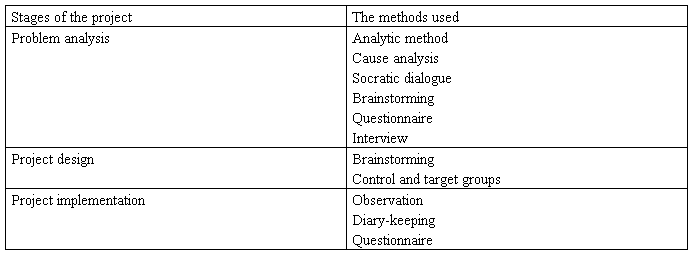
6.10 The results obtained from the project implementation
My hypothesis has been proved to be correct.
7. Conclusion
The present study is chiefly based on the project that I preceded from March, 2009, to May, 2009, which aimed to enhance my students’ interest in doing group work. Eight weeks ago, I determined to work on the crucial problem that my students don’t like doing group work. In my study I used the analytic method, Socratic dialogue, cause analysis, Brainstorming action, questionnaire survey and interview. I found my weak points in my teaching:
Firstly, the way of learning: Some students were lacking interest in studies. Their vocabulary was small, they couldn’t use grammar very well. They even couldn’t complete the group work without other students help.
Secondly, the way of teaching: I should provide more interesting and practical oral tasks.
Thirdly, the division of groups. I just divided the groups according to their seats before. So the students in some groups especially the seats at the back of the classroom were weak in English. When the students did group work, the whole group always kept silent or did nothing with the group work.
I also formulated a specific research objective and a research hypothesis. And then I worked out solutions. Next I implemented my project. I did much improvement when I designed my group work and organized my students to do the group work. After implementing my four-week project, I did a questionnaire survey to see the result. From the data, I think the methods used in problem analysis are suitable, the problem object is realistic, the hypothesis is provable, and the project has a sound basis. Now I can be very happy to state that my problem has been solved ( For instance , most of my students, 75% of them, began liking to do the group work. )
This action research helps me cultivate awareness of the dynamic mechanism in my English teaching. It enables me to acquire unceasing professional development. From the action research, I have gained a lot of benefits. My teaching has been improved considerably with deeper insights to the teaching profession, more acute sensitivity to the oral practice organization and more confidence in myself as a language teacher.
Although I have learned a lot and improved a lot and improved a lot, action research starts me on another cycle of reflection, since I have basically solved one problem and identified another. I will go on with the spiral cycle of reflection which will lead me to the endless process striving for perfect teaching. The final report is drawing to an end but my action research is not. In fact, I’ve only just begun.
References
1. Gu Yueguo 1998 English Teaching Methodology, Foreign Language Teaching and Research Press
2. Go for It!—Teacher’s Book, People Education Press
3. Go for It!—Students’ Book, People Education Press
Appendix
A. The timetable of the project
B. The questionnaire for problem analysis
C. Teaching notes
D. The students’ handout
E. Diaries
F. The post-trial questionnaire
Appendix A: The timetable of the project

Appendix B: Questionnaire for problem analysis
Dear students,
I know you are very busy with your study. But could you spare me some minutes by answering this questionnaire? Your help will improve my teaching, and my better performance will in turn help you to improve your study.
Please tick the box next to the answer that expresses your opinion.
1. Do you like English?
Yes ( ) No ( )
2. Do you think it is useful to master English in the future?
Yes ( ) No ( )
3. Can you finish group work by yourself?
Yes ( ) No ( )
4. Would you like to accept your classmates’ help when you do group work?
Yes ( ) No ( )
5. Do you think your classmates’ help is helpful?
Yes ( ) No ( )
6. Do you think practice English regularly can improve your oral English?
Yes ( ) No ( )
Thank you for your cooperation!
Appendix C:Teaching notes
Week 1:
Date: Friday, April 10, 2009, class 2
Today’s objective: Let students master the expressions which can describe the animals.
Step 1. Revise the names of the animals.
Step 2. Study the description words.
Step 3. Let students match the description words with the animals.
Step 4. Listen and circle the description words you hear.
Step 5. Pair work. Talk about the animals you know.
Step 6. Group work. Have students work in groups of four. Write down what animals your group mates like.
Step 7. Have several students share their reports.
Week 2:
Date: Wednesday, April 15, 2009, class 2
Today’s objective: Talk about jobs. Students can express what he/she wants to be.
Step 1. Revise the names of the jobs.
Step 2. Study the description words.
Step 3. Let students match the words with the pictures.
Step 4. Pair work. Have students talk about the jobs in the pictures above.
Step 5. Listening. Listen to the conversation. Write down “Wants to be ” and “Why”.
Step 6. Group work. Have students work in groups of four. Write down what your group mates want to be and why.
Step 7. Have several students share their reports.
Week 3:
Date: Tuesday, April 21, 2009. class 2
Today’s objective: Students can make a description of somebody’s look.
Step 1. Free talk. Have a student make a introduction of his /her friend.
Step 2. Study new words and expressions.
Step 3. Listen and fill in the blanks in the picture above.
Step 4. Pair work. One of the people in the picture above is your friend .
Describe your friend.
Step 5. Listen. Fill in the chart.
Step 6. Group work. Interview your group mates . Make a report of your group mates’ family member.
Step 7. Have several students share their reports.
Homework: Write down your report.
Week 4:
Date: Monday, April 27, 2009. class 2
Today’s objective: Students can talk about what kind of noodles they would like.
Step 1. Study new words and expressions.
Step 2. Listen and check the noodles that the person orders.
Step 3. Pair work. Have students make conversations.
Step 4. Listen and fill in the blanks.
Step 5. Group work. Work in groups of four. Write down what kind of noodles your group mates would like.
Step 6. Have several students share their reports.
Homework: Write down your reports.
Appendix D: The students’ handouts.
A
Liu Jiaxu’s report:
He Miao likes koalas. Because they’re cute. They are from Australia. Koalas sleep during the day, but at night they get up and eat leaves. Wang Yinglei likes lions. He thinks they’re scary. Lions are from Africa. They eat meat. They usually sleep and relax 20 hours every day. Wei Dan likes pandas. She thinks they’re friendly. They’re from China. They’re beautiful but very shy.
B
Ma Jincheng’s report
He Feixue wants to be a reporter, because it’s an interesting job. Chen Jiyao wants to be an actor because it’s a fun job. Wang Jiayi wants to be a policewoman because it’s an exciting job.
C
Liu Jing Jing’s report:
Qi Yanan’s father is of medium height. He is of medium build. He has short hair. He has black hair. He has straight hair. Zhan Xiaonan’s mother is tall. She is thin. She has long hair. She has curly hair. She has big eyes.
Shang Yuanming’s mother is of medium height. She is heavy. She has short hair. She has curly hair.
D
Zhou Chanyu’s report:
Shan Zhenyi would like tomato and egg noodles. And she’d like a small bowl of noodles.
Xuan Ke would like beef and carrot noodles. He’d like a large bowl of noodles.
Li Na would like chicken and cabbage noodles. She’d like a medium bowl of noodles.
Appendix E: Diaries
Week 1
Date: Friday, April 10, 2009
As usual, when I said that we were going to do group work, some students had no expression on their face. It seemed that they had nothing to do with the group work. Then I said that I would divide the groups newly. Some students showed their curiosities. They wondered whom they would work with.
I asked the students to do group work with their new group mates. Most of the students were excited about the new groups. Some students who were lack of interest in English showed their interest in group work. They could say at least one or two sentences.
Most of the students were happy to do the group work.
Week 2
Date: Wednesday, April 15, 20## class 2
When the students did the group work. I found the changes of the students especially the students who were lack of interest in doing group work. They could listen to others carefully when the other students spoke. Then they could say a few sentences. I could felt they tried their best to make their reports.
Week 3
Date: Tuesday, April 21,2009 class 2
Today I felt very happy to see that the students who were lack of interest in doing group work could ask the other students for help. They tried to say as many sentences as they could. I found they felt happy with their reports.
Week 4
Date: Monday, April 27,2009 class 2
When students did the group work, I found everyone in the group expressed their ideas first. Then they helped each other to correct the mistakes and made the reports better. I found they could cooperated with others. I hoped they could know the importance of cooperation and they could continue cooperating with others. I was very satisfied that the students who were lack of interest in doing group work became more confident. And they were willing to do the group work.
Appendix F The post-trial questionnaire
Dear students,
I know you are very busy with your study. But could you spare me some minutes by answering this questionnaire? Your help will improve my teaching, and my better performance will in turn help you to improve your study.
Please tick the box next to the answer that expresses your opinion.
1. Do you like English?
Yes ( ) No ( )
2. Do you think practice English regularly can improve your oral English?
Yes ( ) No ( )
3. Can you finish group work by yourself?
Yes ( ) No ( )
4. Would you like to accept your classmates’ help when you do group work?
Yes ( ) No ( )
5. Do you think your classmates’ help is helpful?
Yes ( ) No ( )
6. Do you like doing group work?
Yes ( ) No ( )
Thank you for your cooperation!
指导过程报告—1
Process Report--1
Student
Stage 1: Identifying a problem
Tutor’s Comments: (problems and suggestions)
Tutor _______ Date _________ Score_________
Content
I identified a problem based on my teaching experience. That is: Some of my students do not like doing group work. They are not interested in doing group work..
I examined my problem scientifically to see whether it was researchable. I discussed and agreed the problem with the tutor. At the same time, I worked out the timetable of my project.
指导过程报告—2
Process Report--2
Student:
Stage 2: Problem analysis
Tutor’s Comments: (problems and suggestions)
Tutor Date ____________ Score ___________
Content
In my teaching, the problem identified was really a serious problem. My preliminary research confirmed that there were three main reasons that accounted for students’ reluctance to do the group work.
Firstly, the way of learning: Some students were lacking interest in studies. Their vocabulary was small, they couldn’t use grammar very well. They even couldn’t complete the group work without other students help.
Secondly, the way of teaching: I should provide more interesting and practical oral tasks.
Thirdly, the division of groups. I just divided the groups according to their seats before. So the students in some groups especially the seats at the back of the classroom were weak in English. When the students did group work, the whole group always kept silent or did nothing with the group work.
The problem had been troubling me for a long time and now I was determined to find a solution to the problem. In my study, I used six methods of analysis.
指导过程报告—3
Process Report--3
Student
Stage 3: Project design
Tutor’s Comments: (problems and suggestions)
Tutor ___________ Date ____________ Score _______
Content
I designed a large number of activities (cover four weeks of teaching) to test the hypothesis. If group work exercises are better designed, then the learners’ interest in group work will increase accordingly.
To summarize, in my project I decided to improve my teaching. I had designed four activities to be tried out in four weeks.
I set up control and target groups. The implementation of the project takes four weeks. In each week I would ask both groups to do group work according to do the requirements of the book. However for the target group, the above suggested techniques would be employed in turns to deal with their group work exercises, while everything remained the same with the control group. After that, both groups were asked to do group work and I then compared the students’ performance. The results obtained from the comparison should show whether the students in the target group became more interested in group work than the control group. This would show whether the students’ interest in group work could be improved by group work design.
指导过程报告—4
Process Report--4
Student
Stage 4: Project implementation
Tutor’s Comments: (problems and suggestions)
Tutor ___________ Date ____________ Score ____________
Content
My students are sever-year students. It took four weeks for me to implement my project. For each week I were scheduled to do these:
1. Teaching notes 2. Students handout 3. Diary-keeping
I wanted to know if the hypothesis had been proved by the four weeks’ use of teaching design with the target group. I had four sources of data that help me to find it out. All the details of my project implementation were carefully maintained. They were data collection submitted a part of my project report back.
The previous interview I did with my students for the cause analysis of my initial problem.
Classroom observations I took in my diary.
The comparison between the control and the target group.
The questionnaire I asked my students to fill in immediately after the trial of teaching design was over with the target group.
From the above analysis I drew a conclusion learners’ interest in doing group work could be enhanced.
指导过程报告—5
Process Report--5
Student
Stage 5: Project evaluation
Tutor’s Comments: (problems and suggestions)
Tutor ___________ Date ____________ Score ____________
Content
I had evaluated the project by asking and answering relevant questions on the following aspect of it.
1. The problem.
2. The methods used in problem analysis.
3. The project objective.
4. The project hypothesis.
5. The project rationale.
6. The project design.
7. The stages and details of project implementation.
8. The methods used in project implementation.
9. The methods used to obtain the results.
10. The results obtained from the project implementation.
My hypothesis has been proved to be correct.
指导过程报告—6
Process Report--6
Student
Stage 6: Final report
Tutor’s Comments: (problems and suggestions)
Tutor ___________ Date ____________ Score ____________
Content
In this stage, I had finished written the final report. It included the following things: a title page, an acknowledgment, an abstract, a list of contents, the project objective, the project hypothesis, the project rationale and all the relevant facts of the planning, implementation and evaluation of the project in a formal style. Also I had finished written the bibliography and the appendix.
教学实践设计各阶段得分总表
Student
Tutor ______________ Date ______________
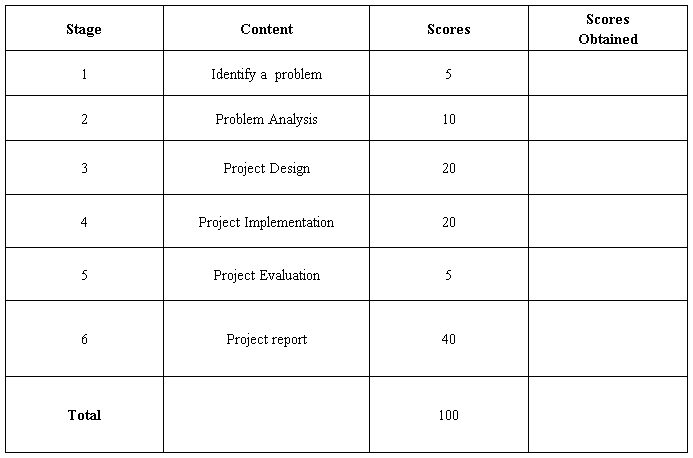
秦皇岛市电大英语专业毕业设计教师指导记录表
中文题目 小组活动设计与学习者的兴趣
英文题目 Group Work Design & Learners’ Interest
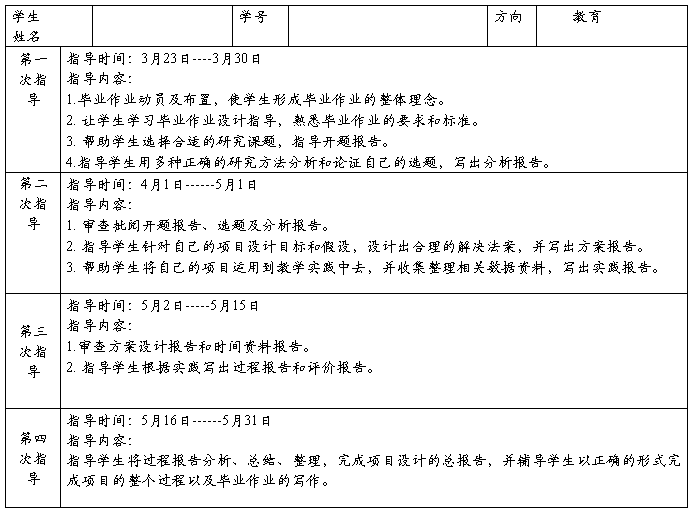
学生签名______________ 教师签名________________
秦皇岛电大英语专业(教育方向)毕业设计开题报告

-
酒店实习英语论文
AbstractLastsummer,undertheguidanceandhelpofourschoolIwenttoBeiji…
-
发表英语论文.doc修改稿(2)12
当前中等职业学校英语教学难点与对策分析张强1○邱红敏2○1襄阳市护士学校湖北襄阳441021;○2襄阳市第十中学湖北襄阳44102…
-
英语论文introduction
英文论文引言的写作技巧Introduction学术论文中的引言(Introduction)是对全文内容和结构的总体勾画。引言尽管不…
-
气象科技英语论文大纲
论气象科技英语中长句的翻译方法摘要:长句是一种很常见的英语语言现象,在气象科技英语中尤为如此。如果一个句子太长,则往往会造成理解和…
-
英语论文
[1]李航.大学英语教学中存在的问题及其应对策略[J].安徽文学(下半月).20xx年06期.[2]杨红梅.大学英语四六级考试对英…
-
英语毕业论文格式模板
英语专业毕业论文写作格式说明一总的装订顺序亦即本说明之排列顺序1外封格式要求2内封中文格式要求3内封英文格式要求4目录格式要求5摘…
-
英语论文模板
英语专业本科毕业论文撰写规范姓名系别专业英语学号指导教师赵草稿ThesisWritingStandardforEnglishMaj…
-
专业英语论文模板
专业英语课程论文院系名称电气工程学院专业班级电气1101学生姓名学号附件1中文论文2外文论文电气工程学院专业英语中文论文格式王立1…
-
英语专业毕业论文开题报告模板
下面是一篇英语论文的开题报告范文虽然不是特别好但也反应了开题报告的格式和写法有一定的借鉴价值FunctionandApplicat…
-
英语论文模板
AbstractTaskbasedteachingisnolongeranewtermHoweveritsapplicationinchinapart…